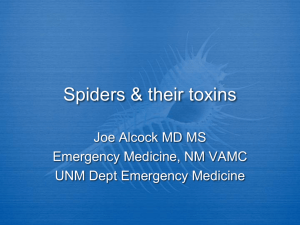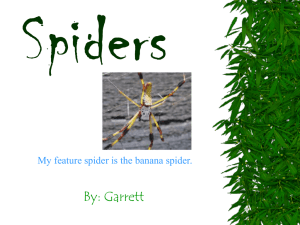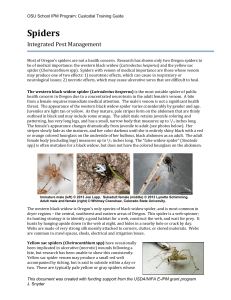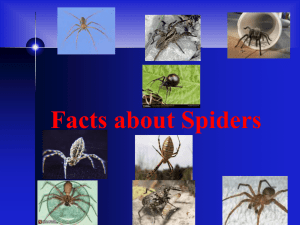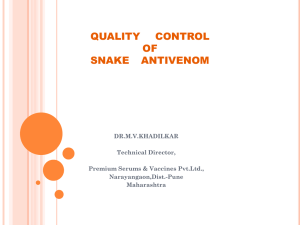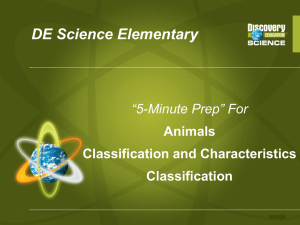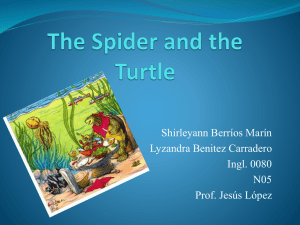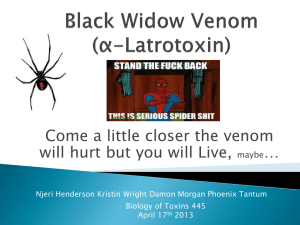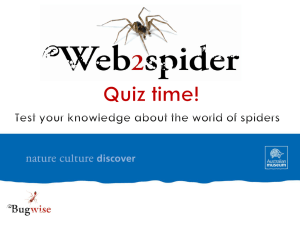Arachnid Envenomations
advertisement
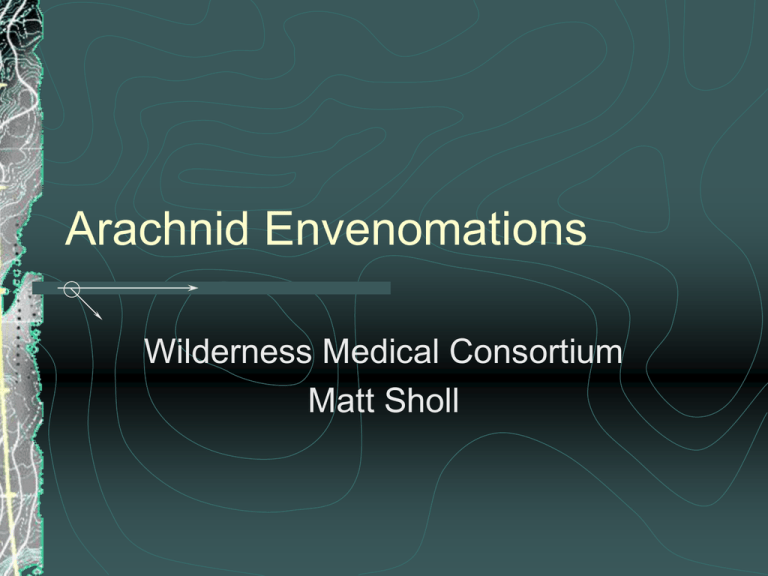
Arachnid Envenomations Wilderness Medical Consortium Matt Sholl General Class Arachnida and phylum Arthropoda comprise ~ 70,000 species Divided into 9 orders Acari (mites and ticks) Araneae (true spiders) Scorpiones (true scorpions) Opiliones (harvesters/daddy-long-legs) Pseudoscorpionidae (false scorpions) Pedipalpi (whip scorpions) Palpigradi (microwhipscorpions) Ricinulei (hooded tick spiders) Solpudida (sun spiders) Of Those…. … The classes important to us are those that cause injury or illness to humans by: Acting as a vector of disease Acari Through direct envenomation Aranae and Scorpiones Outline Focusing on arthropod envenomations Discussing spiders and scorpions Will discuss ticks and tick borne diseases another time Focusing on spiders and scorpions indigenous to North America Hiking the Royces -- WMC Spring trip 2005 Scorpions - General 1200 species grouped into 7 families Buthidae family contains the majority of clinically important scorpions Vary in size from a few millimeters to 15 cm Size does not correlate with its danger In No America - smaller scorpions (Centrurooides) accounts for most envenomations Typically night stalkers and remain hidden during the day Under rocks, plant matter, in burrows or in clothing Incredibly heat tolerant but can live in cold temperatures and at altitude (up to 14,000) Scorpions - Recognition Resemble miniature lobsters Small heads (prosoma) Variable sized claws (pedipalps) 8 paired legs Segmented tail (part of abdomen) Ending in venomous telson Telson composed of a vesicle that stores the venom and a stinger (aculacea) Stinger is a single, slender spike used to pierce the shell or skin of prey/victim Muscular action squeezes venom into the prey through twin openings in its base Recognizing Centurodies One of 41 species of bark scorpions Responsible for the bulk of severe envenomations in No America Slim, yellow-brown scorpion 4 - 7.5 cm in length at maturity Slender pincers Triangular shaped sternum Tubercle at the base of its stinger Limited to Arizona, the base of the Grand Canyon, and the area surrounding Las Vegas and western New Mexico Scorpions - Incidence of Envenomations 2001 American association of Poison Control Centers 14,599 calls related to scorpions stings 851 (6%) required no medical attention No deaths in 2001 Although there are an estimated 5000 deaths world wide per year Scorpion Venom Make-up is variable from species to species but in general: Mixture of single-chain polypeptides containing neurotoxins that block ion channels esp. sodium and potassium channels Secondary effects from release of acetylcholine and catecholimines Hyaluronidase allows spread of the venom Serotonin, lipids, amino acids also reported Dry Stings Scorpions can vary the amount of venom released per sting depending on the victim’s size Several rapid stings can deplete the venom stores Dry stings with no apparent envenomation are common Envenomation - Local Effects Local symptoms are the most notable Include localized, intense pain at the puncture site Pain increases significantly with tapping lightly over the site No focal erythema or edema Symptoms begin shortly after sting and may last for hours May last for weeks Envenomation - Systemic Effects The cause of morbidity and mortality Usually in children and elderly Initially manifested by increased cholinergic tone Salivation, lacrimation, urinary incontinence, defication, gastroenteritis and emisis SLUDGE phenomenon Systemic Effects - cont. Subsequent norepinephrine release causes tachycardia, hypertension, hyperpyrexia, myocardial depression, pulmonary edema Leads to most of the mortality Cardiac effects - MI w/out lesions CNS effects - confusion, agitation, ataxia, myoclonic and dystonic movements Other effects - hyperglycemia, pancreatitis Anaphylaxis rare but has been reported Onset of systemic symptoms is usually with in 6 hours and usually peaks at 12 hours How Common are Systemic Symptoms? 5000 scorpion stings occur each year in Arizona Of these, around 250 result in systemic symptoms 5% Management of Scorpion Stings - Field Treatment Attempts should be made at identification Can be difficult… Treatment begins with local therapy Rest, ice, elevation, splinting and light, compressive dressing Pain management (NSAIDs, Tylenol, narcs) Keep patient calm and resting Six hour observation period to determine if systemic symptoms may manifest ? Evacuation vs. observation Management of Scorpion Envenomation - Antivenom Use of antivenom controversial Even for pt’s with systemic signs Antivenom appears to be species specific Must be administered within 1 hour These factors limit use to areas with known single species and easy access to health care In the US, University of AZ holds antivenom to Centurodies venom Antivenom derived from goat serum 3% incidence of immediate sensitivity 60% incidence of serum sickness More on Antivenom Antivenom appears to assist with local pain and paresthesias Does not appear to help with systemic symptoms, ie. pulmonary edema, MI, CVA These symptoms due to pronounced catecholamine release not toxic effects of venom BUT this is why antivenom must be administered with in 1 hour Not FDA approved and therefore can not be transported over state lines ONLY IN AZ!!! Systemic Effects - Treatment Supportive care likely more benefit than antivenom In the hospital, look for concerning signs and blunt their effects before irreversible damage is done: EKG, cardiac enzymes, FSBG, MS, Sz Hypertension - Nitroprusside agent of choice Pulmonary Edema - O2, Dig, Diuretics, -Blockers (if EF > 50%) and mechanical ventilation Steroids have not been proven helpful Morphine can provoke arrhythmias Nifedipine can initiate heart block and hypotension Prevention of Scorpion Envenomation Wear protective footwear especially at night Exercise caution when lifting rocks, logs and when collecting firewood Do not handle scorpions with bare hands When camping try not to sleep directly on the ground Shake out footwear, clothing and bedding to expel unwanted creepy crawlies Learn how to distinguish a highly venomous scorpion from a harmless one and the area they occur in Spiders Diverse group of 34,000 species divided into 105 families All of the true spiders have unsegmented bodies and the ability to make silk Not all true spiders use silk to make webs Spiders use venom to subdue their prey and begin digestion (no teeth) Can the Venom Injure Humans In order for a spider’s venom to injure a human it must: Have fangs strong enough to pierce a human’s skin Have venom that causes injury to humans Have enough venom to cause injury Several spider families meet these characteristics… Incidence of Spider Encounters Worldwide distribution and thrive in populated areas Results in many bites/year American Association of Poison Control Centers data 2001 - 20,204 calls for spider bites 50% not linked to specific species 1890 (19.7%) sought medical attention No deaths World wide incidence is not known A General Rule for Arachnid Exposures The importance of identifying the culprit spider that caused a bite can not be overstated The diagnosis of spider envenomation DEPENDS on identifying the culprit spider Diagnosis of “spider bite” with out positive identification of the spider is dubious Two General Categories Spiders can be divided into two general categories Spiders that cause local tissue damage Spiders that cause systemic symptoms Some spiders may cause both local and systemic symptoms Some cause injury through other mechanisms Necrotic Arachnidism Defined as local tissue necrosis caused by a spider bite Venom in necrotic arachnids contains Hyaluronidase Levarterenol - like substance Spider fangs may host numerous bacteria End result of envenomation is local tissue distruction via liquifactive necrosis Spectrum of disease from major to minor Loxosceles is the only proven class in the US Other Spiders Many other spiders have been reported to cause necrosis although recently many question the reality of this Wolf Spiders series of 515 documented bites from wolf spiders in brazil showed no necrosis Hobo spiders Introduced from Europe in 1920’s Spread to Pacific NW Allegedly causes necrotic wound and HA Little documentation to confirm and nontoxic in Europe The Main Actor - Loxosceles Characteristic eye pattern Six eyes arranged in pairs Other spiders characteristically have 8 eyes in 2 rows of 4 Pigmented “violin shape” on back Unreliable and commonly misinterpreted May or may not be present in young Brown Recluse Mimics Many other North American spiders mimic the appearance of Brown Recluse spiders Common Eye Pattern Spitting spiders Scytodes genus Common violin shape Cellar spiders NEJM article - attempting to collect any spider identified as Brown Recluse by public > 1700 spiders submitted from 36 spider families Genus Kukulcania most commonly submitted Loxosceles - Distribution Again - only confirmed necrotic arachnoid 11 species of loxosceles in No America Brown Recluse responsible for most envenomations Only active in a specific range in the US May be transported outside this range BUT has little effect on epidemiology Spiders are RARELY verified in states where they are not epidemic Must be very suspicious of a reported bite in a non endemic state Diagnosis of Necrotic Arachnoidism Two important factors Collection and proper identification of responsible spider Characteristic skin findings 600 pts with suspected spider bites at University of AZ or LA County 80% of bites caused by other arthropods Bedbugs, hymenoptera, etc Must be wary of the diagnosis of spider bite in areas where loxosceles is not endemic Diagnosis remains common in areas where the spider has never been confirmed DDX of BR Bites Staph, strep infections Herpes infections Diabetic ulcers Fungal infections Pyoderma gangrenosum Lymphomatoid papulosis Etc. etc. etc. … True Diagnosis of Loxosceles Bite Since numerous disease mimic loxoscelism, diagnosis must be suspected UNLESS spider is caught in the act of biting and can be properly identified Diagnosis remains a clinical judgment Enzyme-linked immunosorbent assay to detect venom in rabbits Not commercially available for humans Treatment Remains controversial Initial care includes routine first aid Rest, immobilization, ice, local wound care, tetanus prophylaxis Reported therapies include: Hyperbaric O2 Dapsone Steroids Electric shock Antibiotics antihistamines, dextran, nitro, excision, antivenom Dapsone Sulfone antibiotic Recommended as treatment for decades Theory behind use - dapsone inhibits chemotaxis of PMN’s and inhibits generation of oxygen free radicals Literature on efficacy split Guinea pig literature suggests decreased lesion size if treated w/in 16 hours Rabbit literature suggests no benefit No human data to date Dapsone - The Down Side Common side effect Hemolysis in all patients Degree is usually not clinically significant Decrease of 1 - 2 g in Hgb Dangerous side effect Severe hemolysis and methemoglobinemia in pts w/ glucose-6-phosphate dehydrogenase deficiency (G6PD) Other side effects HA, GI upset with N/V/D, agranulocytosis, lower motor neuron toxicity, hepatitis Before Dapsone Prior to initiation of therapy, pt’s need: Baseline CBC Baseline LFT’s Baseline assessment of G-6-PD Steroids Commonly administered to pt’s with loxosceles bites Do not retard the formation of ulcers as much as they ameliorate the systemic effects Such as reactive erythema and edema Two studies showed no effects on size or duration of lesions Hyperbaric Oxygen In a study w/out controls, benefit reported Dubious Another human study w/out controls showed “uneventful healing” Neither study actually confirmed lesion was from loxoscelism Rabbit and piglet studies have shown no benefit Electric Shock “…rationale for treating loxosceles bites with electric shock arose after reported success of electric stun guns for field therapy of insect stings and poisonous snakebites” ???? Therapy = energies of 40 - 50 kilowatt seconds delivered for 1 - 2 seconds per pulse Human subject reported improvement over 2 - 5 weeks No controls…. No benefit in animal studies Excision and Grafting Some advocate for excision and graft of all lesions over 1 cm Some advocate for a course of dapsone prior to excision and grafting Small cohorts showed improved results vs. dapsone alone Antivenom Not available in US L. laeta anitivenom in So America Specific or polyvalent antivenom in Brazil 17 pts w/ documented bites No difference between dapsone alone, intralesional antivenom, and combo tx Animal studies suggest that antivenom beneficial if given intralesionally w/in 4 hours of envenomation Spiders that Cause Systemic Symptoms Black Widow Spider Black Widow - General Females are large enough to envenomate humans Males too small 13% of calls to AAPCC for report of Black Widow Bites Recognized by: Glassy-black body Hourglass on ventral surface Black Widow Venom Contains Lacrotoxin Neurotoxin that results in pre-synaptic neurotransmitter release Clinical effects are rapid in onset W/in one hour Include: Muscle spasms Severe abdominal pain Mimics peritonitis HTN and diaphoresis are common Lactrodectus facies Prostration Black Widow - Diagnosis Once again, relies in large part on proper identification of the spider Can be very difficult Commonly mis-diagnosed If diagnosed at all Treatment Antivenom available Allergic reactions to the antivenom seen in 75% of pts up to 14 days out from treatment One reported death from anaphylaxis Preliminary test dose mandatory Due to side effects, antivenom use reserved Recovery is excellent and usually occurs w/in 3 - 7 days Pain treated with IV analgesics IV calcium gluconate ineffective for pain in most case reports
